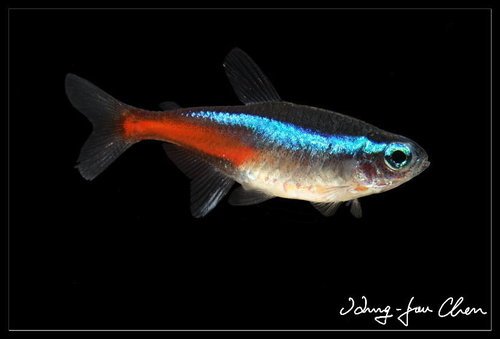
Neon Tetra
The Atlantic bluefin tuna (*Thunnus thynnus*) is a majestic and powerful fish, renowned for its size, speed, and commercial value. It is a highly migratory species, capable of crossing entire oceans. This species has played a significant role in human cultures for millennia, both as a food source and a symbol of strength and endurance.
2 5 years
Lifespan
3 cm
Length
Least Concern
Conservation Status
N/A km/h
Swimming speed
Omnivorous, Detritivorous
Diet
Sedentary
Migration
Appearance Overview
The Atlantic bluefin tuna is renowned for its large, streamlined body, built for speed and endurance.
Color
Dark metallic blue above, silvery white below
Fins
Two dorsal fins, the first depressible; short pectoral fins
Body shape
Torpedo-shaped, with a powerful, crescent-shaped tail
Length
Up to 13 feet (4 meters)
Weight
Up to 2,000 lbs (907 kg)
Diet
Carnivorous, feeding on a variety of fish, squid, eels, and crustaceans.
Feeding Behavior
Highly active predator, using speed and agility to hunt, often cooperatively with other tuna.
Social Behavior
Forms large schools, especially during migration, but can also be found in smaller groups or solitary.
Commercial Relevance
Extremely high value, particularly in the Japanese sushi and sashimi market, where a single fish can fetch hundreds of thousands of dollars.
Conservation measures
Subject to international fishing quotas, stock rebuilding plans, and monitoring efforts by organizations like ICCAT. Some regions have implemented stricter regulations.
Status
Endangered (Varies by population segment; some are considered critically endangered)
Threats
Historical overfishing, continued high demand in luxury markets, bycatch in fisheries targeting other species, and climate change impacts on prey availability.
Habitat Distribution
Depth Range
0-1,000 meters (0-3,280 feet), but most commonly found in the upper few hundred meters.
Geographic Range
Western and Eastern Atlantic Ocean, including the Mediterranean Sea. Some populations undertake trans-Atlantic migrations.
Preferred Environment
Primarily pelagic (open ocean), but also found in coastal waters, particularly during spawning season. Prefers temperate and subtropical waters.
Reproduction and Life Cycle
Breeding Habits
Spawns in warm waters, with major spawning grounds in the Mediterranean Sea and the Gulf of Mexico. Spawning typically occurs in spring and summer.
Development Stages
Eggs hatch into larvae, which are planktonic. Juveniles grow rapidly, feeding on smaller organisms. They gradually develop the streamlined body shape and physiological adaptations of adults.
Fecundity
Highly fecund; a large female can release up to 30 million eggs per spawning season.
Maturity Age
Varies by population; Mediterranean bluefin mature earlier (around 4-5 years) than Western Atlantic bluefin (around 8-12 years).
Faqs about Neon Tetra
Where can Atlantic bluefin tuna be found?
Atlantic bluefin tuna are found in the Atlantic Ocean, from the Mediterranean Sea to the Gulf of Mexico, and from Norway to the Canary Islands.
What do Atlantic bluefin tuna eat?
They primarily eat smaller fish like herring, mackerel, and sardines, as well as squid and crustaceans.
Why are Atlantic bluefin tuna endangered?
Overfishing has severely depleted their populations, making them one of the most valuable and endangered fish species.
How fast can Atlantic bluefin tuna swim?
They can reach speeds up to 43 mph (70 km/h) in short bursts.
How many eggs do Atlantic bluefin tuna lay?
Females can release millions of eggs during spawning season, though survival rates to adulthood are low.
Are Atlantic Bluefin Tuna warm-blooded?
They are warm-blooded, unlike most fish, which allows them to maintain high activity levels in cold waters.
What are the predators of Bluefin Tuna?
They are apex predators, meaning they are at the top of the food chain and have few natural predators besides orcas and large sharks.
When do Bluefin Tuna reach maturity?
Atlantic bluefin tuna typically reach sexual maturity between 4 and 8 years of age, depending on the population.
How do Bluefin Tuna maintain their body temperature?
Bluefin tuna have a specialized blood vessel structure called a countercurrent heat exchanger, which helps them retain heat in their muscles.
Copyright @ Nature Style Limited. All Rights Reserved.
 English
English